Effective Use of Color in Photography: A Guide for Beginners
Color is a powerful element in photography, capable of conveying emotions, creating visual impact, and enhancing the overall aesthetic of your images. Understanding how to effectively use color is a key skill for photographers. Whether you're capturing vibrant landscapes, dynamic portraits, or intriguing still lifes, this guide for beginners will help you harness the full potential of color in your photography.
Effective Use of Color in Photography A Guide for Beginners - picviw.com
1. Understand the Color Wheel:
Familiarize yourself with the color wheel, which consists of primary colors (red, blue, and yellow), secondary colors (green, orange, and purple), and tertiary colors. Understanding color relationships and harmonies can guide your choices in composing visually appealing photographs.
2. Consider Color Temperature:
Color temperature refers to the warmth or coolness of light in a scene. Daylight is typically cooler, while artificial light sources can be warmer. Adjust your camera's white balance settings to capture accurate and pleasing colors under different lighting conditions.
3. Embrace Color Harmony:
Create harmonious color combinations by using analogous or complementary colors. Analogous colors (next to each other on the color wheel) create a serene and cohesive feel, while complementary colors (opposite each other) add vibrancy and contrast.
4. Utilize Color Psychology:
Colors evoke emotions and moods. Understand the psychological impact of colors and use them intentionally to convey the desired feelings in your photographs. For example, warm tones like red and orange can evoke energy and passion, while cool tones like blue and green may convey calmness and tranquility.
5. Pay Attention to Color Contrast:
Contrast in color can make your subject stand out. Use a contrasting background or incorporate complementary colors to emphasize the main elements in your composition.
6. Experiment with Monochromatic Photography:
Monochromatic images focus on a single color or variations of a single color. Experiment with this technique to create a cohesive and minimalist aesthetic, emphasizing the nuances within a specific hue.
7. Use Color Blocking:
Color blocking involves placing solid areas of different colors next to each other in a composition. This technique creates bold, visually striking images and can be particularly effective in fashion and portrait photography.
8. Consider the Impact of Color in Post-Processing:
During post-processing, pay attention to color adjustments. Enhance or mute colors to achieve the desired mood. Experiment with saturation, vibrance, and color grading to fine-tune the overall color palette.
9. Capture Vibrant Landscapes:
In landscape photography, vibrant colors can bring scenes to life. Capture the warm hues of a sunset, the rich greens of a forest, or the vivid blues of a clear sky. Consider the time of day and weather conditions for optimal color saturation.
10. Explore Color in Portraiture:
Use wardrobe, props, and backgrounds to complement or contrast with the colors in your portraits. Pay attention to skin tones and how they interact with the overall color scheme of the image.
11. Tell Stories with Color:
Colors can be used to tell stories or convey themes in your photography. A series of images with consistent color tones can create a cohesive visual narrative.
12. Be Mindful of Color Distractions:
While vibrant colors can enhance a photo, be mindful of color distractions that may divert attention from your main subject. Simplify your composition to ensure that colors contribute to the overall visual impact.
13. Experiment with Unconventional Color Combinations:
Break away from conventional color schemes and experiment with unexpected combinations. Unusual color pairings can add a unique and avant-garde touch to your photographs.
14. Practice and Learn from Others:
Practice incorporating color effectively in your photography. Analyze the work of established photographers and study how they use color to convey their artistic vision. Learn from both successful and experimental uses of color.
15. Stay Open to Creativity:
Photography is an art form, and the use of color is a dynamic and creative process. Stay open to experimentation, take risks, and let your personal style emerge through your exploration of color in photography.
Conclusion: Adding Life to Your Images
Effective use of color is a skill that evolves with practice and observation. As a beginner, don't be afraid to embrace the vibrant world of colors and experiment with different techniques. Over time, you'll develop a keen eye for color, allowing you to create images that not only capture the scene but also evoke emotions and tell compelling stories. Happy shooting!





